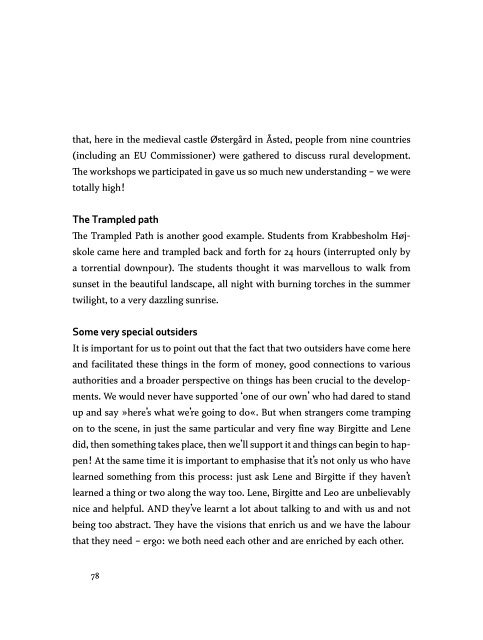Grasslands (eng)
GRASSLANDS has a sharp focus on Danish rural areas, and attempt to contribute to a more nuanced and qualified debate on rural development, through art projects.
GRASSLANDS has a sharp focus on Danish rural areas, and attempt to contribute to a more nuanced and qualified debate on rural development, through art projects.
You also want an ePaper? Increase the reach of your titles
YUMPU automatically turns print PDFs into web optimized ePapers that Google loves.
Endeavouring to live in the world together<br />
– How a contemporary and participatory art project<br />
like <strong>Grasslands</strong> can revitalise the legacy of the artistic<br />
ideals of the 20 th century avant-garde<br />
that, here in the medieval castle Østergård in Åsted, people from nine countries<br />
(including an EU Commissioner) were gathered to discuss rural development.<br />
The workshops we participated in gave us so much new understanding – we were<br />
totally high!<br />
The Trampled path<br />
The Trampled Path is another good example. Students from Krabbesholm Højskole<br />
came here and trampled back and forth for 24 hours (interrupted only by<br />
a torrential downpour). The students thought it was marvellous to walk from<br />
sunset in the beautiful landscape, all night with burning torches in the summer<br />
twilight, to a very dazzling sunrise.<br />
Some very special outsiders<br />
It is important for us to point out that the fact that two outsiders have come here<br />
and facilitated these things in the form of money, good connections to various<br />
authorities and a broader perspective on things has been crucial to the developments.<br />
We would never have supported ‘one of our own’ who had dared to stand<br />
up and say »here’s what we’re going to do«. But when strangers come tramping<br />
on to the scene, in just the same particular and very fine way Birgitte and Lene<br />
did, then something takes place, then we’ll support it and things can begin to happen!<br />
At the same time it is important to emphasise that it’s not only us who have<br />
learned something from this process: just ask Lene and Birgitte if they haven’t<br />
learned a thing or two along the way too. Lene, Birgitte and Leo are unbelievably<br />
nice and helpful. AND they’ve learnt a lot about talking to and with us and not<br />
being too abstract. They have the visions that enrich us and we have the labour<br />
that they need – ergo: we both need each other and are enriched by each other.<br />
Trine Rytter Andersen<br />
Art critic and artist<br />
Since the 1990’s an increasing number of Danish artists have become involved<br />
with communities that work actively and inter-disciplinarily with identity, history<br />
and social structures.<br />
Playgrounds, community allotments, urban parks, fixing rooms, dinners,<br />
blind dates and democracy workshops have been established or arranged, among<br />
other things. Typical for all these projects is that that they intercede in daily life<br />
and try to str<strong>eng</strong>then communities while simultaneously attempting to mobilise<br />
and qualify citizens’ initiative, agency and self-determination. Another common<br />
trait is that they support the proposition that art, as edification and contextualisation,<br />
can motivate those it mobilises to <strong>eng</strong>age in binding democratic processes<br />
that benefit both the community and the individual.<br />
The development of the avant-garde in the 20 th century<br />
The idea that art should play a role in society and contribute to citizen’s awareness<br />
and commitment is not new. Ever since the inception of the historical Avantgarde,<br />
around 1910, the question of how to free the individual from the oppressive<br />
structures of society has been to the fore. Avant-garde artists employed<br />
different strategies from each other, but shared the same goal. They wanted to<br />
develop a coherent political, existential and social life practice. They also wanted<br />
to chall<strong>eng</strong>e convention and habit to awaken the individuals’ aesthetic and social<br />
understanding, so that he or she would be better equipped to protest and empower<br />
themselves.<br />
78<br />
79




